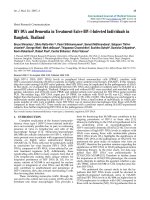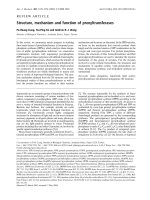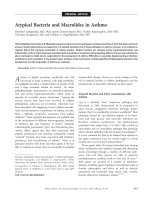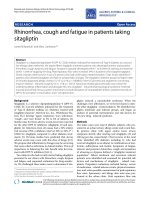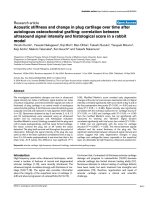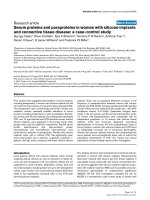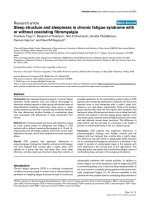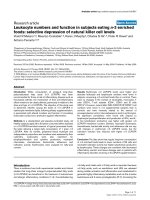Báo cáo y học: "Fast, cheap and somewhat in control." doc
Bạn đang xem bản rút gọn của tài liệu. Xem và tải ngay bản đầy đủ của tài liệu tại đây (290.6 KB, 6 trang )
Genome Biology 2006, 7:114
comment
reviews
reports
deposited research
interactions
information
refereed research
Opinion
Fast, cheap and somewhat in control
Adam P Arkin*
†‡
, Daniel A Fletcher
†§
Addresses: *Howard Hughes Medical Institute, Department of Bioengineering, University of California, Berkeley, CA 94720, USA.
†
Physical
Biosciences Division, E.O. Lawrence Berkeley National Laboratory, Berkeley, CA 94720, USA.
‡
Virtual Institute of Microbial Stress and
Survival, Berkeley, CA 94710, USA.
§
Department of Bioengineering, University of California, Berkeley, CA 94720, USA.
Correspondence: Adam P Arkin. E-mail:
Published: 30 August 2006
Genome Biology 2006, 7:114 (doi:10.1186/gb-2006-7-8-114)
The electronic version of this article is the complete one and can be
found online at />© 2006 BioMed Central Ltd
Manipulating biology through the ages
The natural world around us is not quite so natural. Over
many generations, societies have engaged in a struggle to
mold nature to serve the needs, real and perceived, of their
members. From cultivating grains to mining coal, we have
sought to address local and global demands for food,
shelter, health, and convenience through technology
guided by science. One of the earliest and most profound of
human engineering inventions was biotechnology in the
form of farming, starting about 12,000 years ago. This was
later transformed into a true domestication of animal and
plant species that might be defined as “genetic alteration
through conscious or unconscious selection” [1]. It pro-
vided the key foundation for the spread and stability of
human societies and has become one of the most central
and longest-lived sciences there is. In more modern times,
a scientific/rational basis for domestication and control of
biological organisms has been sought both to make breed-
ing organisms for human purposes quicker and more suc-
cessful, and to limit the spread of infectious disease and
other invasive species. The eradication of smallpox and the
near-eradication of polio stand as reminders of how
advanced medical, industrial and social engineering can
change the health of an entire world. The precision of mol-
ecular biology has led to a whole new form of domestica-
tion and industry. Launched by the first mass production
of a human protein (somatostatin) in bacteria, industrial
genetic engineering became one of the most transforming
industries of the 20th century [2]. After the introduction of
genetically engineered herbicide- and insect-resistant
crops in 1995, genetically engineered maize is now more
than 20% of the US crop, and approximately 80% of the US
soybean crop is now genetically engineered [3].
Engineered biological systems are being used to address a
wide variety of society’s needs. Examples include the pro-
duction of insulin and more than 200 other biopharmaceuti-
cals and countless natural products, industrial catalysts and
bioenergy substrates such as sugars, ethanol, methane and
hydrogen, in microbes, eukaryotic cells and higher organ-
isms; engineered resistance, ripening, oil production and
nutrient overexpression in plants [4]; and more exotic suc-
cesses such as the use of cytokine-expressing Mycobac-
terium bovis BCG as an effective treatment for certain forms
of bladder cancer [5]. These successes have largely been ‘one
offs’, however; each one is a special case, and while lessons
were learned, they do not provide a definitive roadmap for
the next advance. Could it be any different? Could each small
success make the solution of major problems easier? The
increasing number of such special cases, as well as society’s
growing need for solutions to energy and environmental
problems, presages the need for a more rational and inte-
grated approach to engineering biology.
We can learn lessons from other engineering fields. Products
such as the personal computer and cellular phone have at
Abstract
Efforts to manipulate living organisms have raised the question of whether engineering principles
of hierarchy, abstraction and design can be applied to biological systems. Here, we consider the
practical challenges to controlling living organisms that must be surmounted, or at least managed,
if synthetic biology and cellular bioengineering are to be productive.
their foundation deep fundamental theory and technology
from solid-state physics, materials science, and computa-
tional and information theory. These foundations enable
the predictable control of materials and processes through
the application of physical laws to meet specific objectives.
In addition, the industry surrounding these devices has
defined a set of standards and protocols that make the
parts and systems of these devices (often) interoperable,
extensible and, most importantly, allow the efficient scale-
up of manufacture and distribution of the technology. The
practice of engineering has a broadly successful track
record of addressing social needs (as well as creating addi-
tional problems) when applied to materials like silicon and
steel, where the physical rules are known and the complex-
ity is limited or very well controlled. Engineering as a prac-
tice has not, however, been successful in such endeavors as
controlling the weather or avoiding natural disasters, due
largely to the scale, complexity and uncertainty inherent to
those problems. So we must ask: is the conventional para-
digm of engineering appropriate for biology? Can we
develop, or deal with, the lack of a coherent theoretical and
physical foundation for living systems? Or is control of
biology destined for the same fate as rainmaking?
Why should biology be engineerable?
Given the complexity of biology, an engineering approach
based on design may seem an unlikely route to success.
Living systems, unlike classical engineered systems, grow
and evolve, and have material properties that are not easily
controlled or predicted and that are often sensitive to their
local environment. Indeed, traditionally directed evolution
through selective breeding of, for example, pest-resistant
or high-yield crops has been the main method for obtain-
ing a desired outcome in biology. This is true at the biomol-
ecular level as well, in which creation of new function in
proteins and nucleic acids is often accomplished through
directed evolution rather than de novo design [6,7]. The tech-
nology for direct, rational manipulation of an organism’s
DNA has improved in precision and efficiency, greatly
increasing our ability to produce therapeutics, natural
products, antibodies and enzymes in heterologous systems.
Yet actually achieving, let alone optimizing, the production
of a given target in a given system is still a time-consuming
art driven by decades of empirical observation. Engineer-
ing of more complex behaviors will require a more princi-
pled understanding of biological system design.
Basic research over the past few decades has given us con-
fidence that there is at least some organized structure to
the workings of cells - a structure that may be altered or
even rebuilt through an intelligent process of engineering.
This view is emerging from multiple disciplines. Compara-
tive genomics is helping to uncover the structure and evo-
lution of the genome. Large-scale tracking of DNA
expression, protein synthesis, molecular interactions and
intermediates is revealing groups of molecules that work
and play together. Fluorescent imaging of living cells is
identifying time-dependent changes in protein activity and
localization that correlate with behavior. Reconstitution of
biochemical and biophysical processes from ‘minimal
systems’ of proteins has built confidence that top-down
and bottom-up approaches to biology meet somewhere in
the middle. Systems biology has sought to integrate these
results and data to reverse-engineer an understanding of
biological network function and dynamics. Finally, the
infrastructure for storing and disseminating information
on biological systems, and for modeling them, has grown
concurrently. In turn, this allows the rapid access and
cross-comparison of information that is critical to estab-
lishing data quality and creating interoperability standards
that will enable biologists to leverage their efforts and
build scalable systems.
The key observation that biological systems exhibit some
degree of modularity underlies the current belief that useful
and ‘engineerable’ design principles exist [8]. Whether at
the level of protein motifs with similar binding properties or
groups of proteins that carry out specific functions in a
variety of distinct settings, the modular parts of biological
systems are used and reused to generate and control the
apparently complex behavior of living organisms. The bold
question that was asked at the dawn of recombinant DNA
research, and continues to be asked today, is whether a
growing understanding of this modularity and new tools to
manipulate it can be used to engineer new and useful
behavior. Attempts to directly answer this question - and to
think about its consequences - have resulted in the forma-
tion of a loose assembly of scientists, engineers, ethicists
and other thinkers engaged in what has become known as
‘synthetic biology’.
What sets synthetic biology apart from molecular biology
and its closely allied fields of genetic and metabolic engi-
neering is the ambition to formalize the process of design-
ing cellular systems, in the way that traditional engineering
disciplines have formalized design and manufacture, so
that complex behaviors can be achieved for practical ends.
Such behaviors will require larger biochemical circuits,
typically encoded in DNA, for control. To achieve this, syn-
thetic biologists look to move beyond the qualitative and
often ad hoc engineering pathways that have underlain the
slow progress to this point. The goal, instead, is to create a
systematic engineering science founded on the standard-
ization of a cellular ‘chassis’ - the types of parts available,
their manufacture, their characterization and protocols for
their interconnection - analogous to those that underlie
and enable the scalability of mechanical, electrical and civil
engineering. But the analogy with traditional engineering
should not be taken too far, as there are challenges to engi-
neering biology that no internal combustion engine or
microprocessor has faced.
114.2 Genome Biology 2006, Volume 7, Issue 8, Article 114 Arkin and Fletcher />Genome Biology 2006, 7:114
What are the engineering challenges?
Despite much effort, the dream of engineering biology has
not yet led to simple and rapid construction of biological
organisms that address specific problems. The reasons for
this are twofold. One is the lack of a technology infrastruc-
ture that enables production of biological parts and easy
assembly of these parts into systems, a challenge that has
been addressed in a recent review [9]. The second, which we
focus on here, is the difficulty of predicting what biological
components will do, even when the parts are readily obtain-
able and much is known about them individually [10]. On
this issue, lessons learned from engineering bridges, boats
and planes are of little help, because the operating condi-
tions under which biological systems function are signifi-
cantly different from those of familiar macroscopic systems.
Thermal fluctuations that drive stochastic behavior can typi-
cally be ignored or managed in traditional engineering, but
often not in cells. And in situ evolutionary change in parts
and control systems are simply not problems for inanimate
objects - not so for biology. In fact, biology’s success - its
ability to grow and evolve new solutions and test fitness
through competition - has depended on just those behaviors
that frustrate predictability. Any engineering of biology to
serve our needs must recognize, understand and manage
this drive towards variation and the evolutionary competi-
tion with other organisms. Some of these issues are already
under practical consideration in relation to genetically modi-
fied organisms [11].
Engineering exogenous protein or gene circuits into a new
host organism also faces problems of integration due to ‘par-
asitic’ effects and cross-talk with existing pathways. Parasitic
effects that arise due to direct interaction among new com-
ponents or through indirect interactions via their effects on
the organism into which they are introduced - the chassis -
such as sickening it or draining inputs to other pathways,
often play a dominant role in preventing circuit function. To
be broadly useful, the features of a biological component and
the organism into which it is introduced must be character-
ized such that its function is predictable. Most circuit
designs rely, at least in part, in transferring natural compo-
nents from other organisms into the host chassis. There are
basic problems of adapting the part for operation in the new
host by, for example, adjusting codon usage, and as the part
did not coevolve with the other parts of the chassis it might
cross-react with other components in unforeseen ways.
Zarrinpar et al. [12] elegantly demonstrated this in yeast by
showing that a yeast Pbs2 protein binds specifically to SH3
(Src homology 3) domains from yeast but is promiscuous
with SH3 domains from other organisms. These issues are
compounded when design moves away from the single cell
and towards multicellularity, as some researchers are now
attempting [13,14].
To demonstrate the challenges of engineering biology to
control behavior, we use two simple examples: one
addresses how evolution could degrade biological circuit
performance over time; and the other addresses how noise,
possibly external to the system, can have dramatic effects on
system behavior. In the first example, we borrow a model for
competition between multiple strains of a microbe under
nutrient-limiting conditions in continuous culture [15]. We
assume that there are two quasispecies of bacterium, one
bearing a functional version of our synthetic biological
circuit and the other carrying a disabled version created by
deleterious mutation from the first. The deleterious muta-
tion rate is a function of circuit size in base pairs (bp), basal
mutation rate in base pairs per generation, the generation
time itself, and a factor related to the specific circuit design,
which gives the fraction of mutations leading to loss of func-
tion of the circuit. The basal mutation rate, m, in Escherichia
coli is approximately 5.4 x 10
-10
base-pairs per cell per gen-
eration; the fraction of mutations that actually disable the
circuit, f, is a free parameter, which for this simulation we
set to 1/1,000. The circuit size for a small two-gene circuit is
approximately 2,000 bp. We vary this parameter in the fol-
lowing calculations, holding f constant for convenience,
although, in reality, for each circuit design f is a variable. We
also assume that having a functioning circuit places a meta-
bolic load on the cell that slows its growth rate. This load has
been observed experimentally in a number of cases, but
there are few hard and fast rules [16-18]. A disabling muta-
tion can release this load, leading to faster growth of the
mutant population. The deleterious mutation rate sets a
threshold above which, over time, the nonfunctional mutant
population can outcompete the wild-type population.
Figure 1 shows the results of a calculation of the time for the
mutant population to become the majority under different
circuit sizes and growth differences, starting from an initial
condition of a pure wild-type population. Even with rela-
tively modest growth differences and relatively small circuit
sizes it is only a matter of days before the mutant takes over
the population. You et al. [19] observed this in a synthetic
population-control circuit in which mutants that escape the
circuit control arise in 3-6 days (the You circuit is approxi-
mately 4,000 bp long). In many ways, the above example is a
best-case calculation because of the restriction to only the
simplest of mutation mechanisms and the resulting popula-
tion structure, as well as the relative mildness of the growth
differences explored. In practice, the use of selectable
markers could, of course, aid in preventing such takeovers.
However, these markers may be disabled when the circuit
function is disabled, and it is not obvious how to design for
this when complex behaviors are encoded. Error-tolerant
(robust) designs can minimize f, but the principles for apply-
ing this to biological design are still in their early develop-
ment [20-22].
A second example of how an engineered biological system
can evade control arises when we consider the biophysics
of reaction networks in cells. It has become clear that the
comment
reviews
reports
deposited research
interactions
information
refereed research
Genome Biology 2006, Volume 7, Issue 8, Article 114 Arkin and Fletcher 114.3
Genome Biology 2006, 7:114
discrete and stochastic nature of chemical reactions can play
an important role in cellular behavior, in part because many
cellular processes are governed by small numbers of mole-
cules. A number of recent papers describe synthetic biologi-
cal constructs for exploring the effect of noise on these
low-molecular number processes [23-30]. Even in cases
where the numbers of molecules are not too small, stochastic
effects can have surprising consequences. Theoretically, the
addition of a small amounts of external noise to a ubiquitous
biological network motif, the enzymatic futile cycle (in which
a protein undergoes continuous cycles of phosphorylation
and dephosphorylation under the control of kinases and
phosphatases), can lead to different qualitative behavior
than that predicted by the deterministic equations [31]. In
fact, different types of noise can lead to dramatically different
behaviors of the futile cycle, including different signal amplifi-
cation, switching and oscillation properties. Figure 2 shows a
simple analysis (from [31]) that shows the bifurcation from
monostable to bistable behavior that occurs in a futile cycle
as the distribution of the small noise term added to the
forward enzyme is changed. There might be different exoge-
nous noise sources under different environmental condi-
tions in which the engineered organism finds itself, and
thus this subcircuit could behave in ‘unexpected’ ways. In
turn, these might impact greatly on the fitness of the organ-
ism [32-34].
The first of these two simple examples demonstrates that
two of the key properties of a cellular chassis and its environ-
ment that need to be engineered are the basal mutation rate
and the robustness to circuit load, which should, generally,
both be minimized. Furthermore, the particular design
choices made in part choice and in the mechanisms by which
these parts are hooked together to make a system will affect
the value of f, the deleterious mutation rate. The second of
these examples shows how even a simple biochemical
system can exhibit complex unintended behaviors if the
environment in which it operates changes only its noise
properties (even if the mean values stay the same). Thus a
designed cell that is passing through uncertain or multiple
environments will have to be designed to minimize or even
to exploit these effects. In fact, outside bioreactors, engi-
neered organisms - other than a few agricultural examples -
survive poorly in real-world environments where conditions
and competition with other organisms are less controlled
[35]. Both the cases described here demonstrate special
considerations that must be applied to the engineering of
biological systems in order to meet the challenges to the
scalability of engineered organisms.
Immediate goals and future prospects
As we have for millennia, we are shaping the biological world
to meet our needs. There are major problems that cry out for
biologically engineered solutions, such as those in cell and
tissue engineering, gene therapy, biologically derived mate-
rials, biocatalysis and natural product synthesis, optimiza-
tion of agricultural yield and nutrition, pest and disease
control and much more. Synthetic biology, with its focus on
elucidating and harnessing design principles of living
systems, aims to tackle these problems. But unlike other
engineering disciplines, synthetic biology has not developed
to the point where there are scalable and reliable approaches
to finding solutions. Instead, the emerging applications are
most often kludges that work, but only as individual special
cases. They are solutions selected for being fast and cheap
and, as a result, they are only somewhat in control (with
apologies to Errol Morris).
Yet there is optimism in the field. Engineering biology is
indeed a great challenge, but its potential benefits are even
greater. Through the creative efforts of many investigators,
solutions to robustness and noise suppression may be found
- or we will at least understand why no solutions can be
114.4 Genome Biology 2006, Volume 7, Issue 8, Article 114 Arkin and Fletcher />Genome Biology 2006, 7:114
Figure 1
The takeover of a nonfunctional mutant with a higher growth rate in a
population. The predicted time (in days) to a nonfunctional mutant strain
of a synthetic microbe becoming the majority of the population as a
function of the log of the circuit size and the ratio of growth rate of the
mutant to that of wild type. The circuit size is a proxy for the cross-
section of the circuit for deleterious mutation, which is also a function of
growth rate, basal mutation rate m and circuit architecture. The larger
the size and larger the growth advantage of the mutant strain, the faster
the population loses function. The inset shows a schematic of the
underlying model which tracks competitive growth (g) of a wild-type (wt)
population and mutant (mut) population on a common resource (S) in
continuous culture. ks is the influx rate of resource into the bioreactor
and d is the dilution rate of cell and substrate out of the reactor. The
parameter m is proportional to circuit size and is the rate of production
of non-functional (and growth competitive) mutants from the wild-type
population.
1
2
3
4
5
1.05
1.10
1.15
1.20
1.25
1.30
1.35
1.40
0
100
200
300
400
500
Log
10
[circuit size (bp)]
S
k
s
g
mut
g
wt
d
d
m
d
mutwt
Time to majority (days)
Relative growth rate (g
m
ut
/g
w
t
)
found. Further effort and investment are required to develop
robust theories and computational infrastructure for biologi-
cal circuit design and synthesis, to establish standards in
measurement and information about circuits and their inter-
operability, and to create new manufacturing technologies
that allow production of large circuits, creation of novel
chasses (with, for example, new genetic codes [36]), and
environments for the development of artificial tissues.
Excitement among those engaged in engineering biology
stems from the fact that there are clear routes to progress on
all of these fronts and from the incredible pull of the applica-
tions that are possible if these problems are solved.
Acknowledgements
We thank David Schaffer for a critical reading of the manuscript. In
this work A.P.A. is supported by the Howard Hughes Medical Insti-
tute and by the Virtual Institute for Microbial Stress and Survival
[37] supported by the US Department of Energy, Office of Science,
Office of Biological and Environmental Research, Genomics
Program:GTL through contract DE-AC02-05CH11231 between
Lawrence Berkeley National Laboratory and the US Department of
Energy. D.A.F. acknowledges NSF and NIH funding during the
course of this work.
References
1. Janick J: Perspectives on New Crops and New Uses. Volume 4. Edited by
Janick J. Phoenix, Arizona: ASHS Press; 1999:104-110.
2. Itakura K, Hirose T, Crea R, Riggs AD Heyneker HL, Bolivar F,
Boyer HW: Expression in Escherichia coli of a chemically syn-
thesized gene for the hormone somatostatin. Science 1977,
198:1056-1063.
3. Adoption of Genetically Engineered Crops in the US
[ />4. Capell T, Christou, P: Progress in plant metabolic engineering.
Curr Opin Biotechnol 2004, 15:148-154.
5. Kassouf W, Kamat AM: Current state of immunotherapy for
bladder cancer. Expert Rev Anticancer Ther 2004, 4:1037-1046.
6. Bloom JD, Meyer MM, Meinhold P, Otey CR, MacMillan D, Arnold
FH: Evolving strategies for enzyme engineering. Curr Opin
Struct Biol 2005, 15:447-452.
7. Bornscheuer UT: Trends and challenges in enzyme technol-
ogy. Adv Biochem Eng Biotechnol 2005, 100:181-203.
8. Wolf DM, Arkin AP: Motifs, modules and games in bacteria.
Curr Opin Microbiol 2003, 6:125-134.
9. Endy D: Foundations for engineering biology. Nature 2005,
438:449-453.
10. Sprinzak D, Elowitz MB: Reconstruction of genetic circuits.
Nature 2005, 438:443-448.
11. Kirk TK, Carlson JE, Ellstrand N, Kapuscinski AR, Lumpkin TA,
Magnus DC, Magraw DB, Nester EW, Peloquin JJ, Snow AA, et al.:
Biological Confinement of Genetically Engineered Organisms. Washington
DC: National Academies Press; 2004.
12. Zarrinpar A, Park SH, Lim WA: Optimization of specificity in a
cellular protein interaction network by negative selection.
Nature 2003, 426:676-680.
13. Basu S, Mehreja R, Thiberge S, Chen MT, Weiss R: Spatiotempo-
ral control of gene expression with pulse-generating net-
works. Proc Natl Acad Sci USA 2004, 101:6355-6360.
14. Basu S, Gerchman Y, Collins CH, Arnold FH, Weiss R: A synthetic
multicellular system for programmed pattern formation.
Nature 2005, 434:1130-1134.
15. Hansen SR, Hubbell SJ: Single-nutrient microbial competition:
quantitative agreement between experimental and theo-
retically forecast outcomes. Science 1980, 207:1491-1493.
16. Flores S, de Anda-Herrera R, Gosset G, Bolivar FG: Growth-rate
recovery of Escherichia coli cultures carrying a multicopy
plasmid, by engineering of the pentose-phosphate pathway.
Biotechnol Bioeng 2004, 87:485-494.
17. Neubauer P, Lin HY, Mathiszik B: Metabolic load of recombi-
nant protein production: inhibition of cellular capacities for
glucose uptake and respiration after induction of a heterol-
ogous gene in Escherichia coli. Biotechnol Bioeng 2003, 83:53-64.
18. Haddadin FT, Harcum SW: Transcriptome profiles for high-
cell-density recombinant and wild-type Escherichia coli.
Biotechnol Bioeng 2005, 90:127-153.
19. You L, Cox RS, Weiss R, Arnold FH: Programmed population
control by cell-cell communication and regulated killing.
Nature 2004, 428:868-871.
20. McAdams HH, Arkin A: Towards a circuit engineering disci-
pline. Curr Biol 2000, 10:R318-R320.
21. Gerdes SY, Scholle MD, Campbell JW, Balazsi G, Ravasz E, Daugherty
MD, Somera AL, Kyrpides NC, Anderson I, Gelfand MS, et al.: Exper-
imental determination and system level analysis of essential
genes in Escherichia coli MG1655. J Bacteriol 2003, 185:5673-5684.
22. Albert R, Jeong H, Barabasi AL: Error and attack tolerance of
complex networks. Nature 2000, 406:378-382.
23. Swain PS, Elowitz MB, Siggia ED: Intrinsic and extrinsic contri-
butions to stochasticity in gene expression. Proc Natl Acad Sci
USA 2002, 99:12795-12800.
24. Cai L, Friedman N, Xie XS: Stochastic protein expression in
individual cells at the single molecule level. Nature 2006,
440:358-362.
25. Pedraza JM, van Oudenaarden A: Noise propagation in gene
networks. Science 2005, 307:1965-1969.
comment
reviews
reports
deposited research
interactions
information
refereed research
Genome Biology 2006, Volume 7, Issue 8, Article 114 Arkin and Fletcher 114.5
Genome Biology 2006, 7:114
Figure 2
The effects of noise on an enzymatic futile cycle. The cycle is formed by
the phosphorylation of a protein X to form X* through the action of a
kinase, E+, which may or may not be subject to noise in its activity. Each
curve is a plot of the stationary-state concentration of X*, from the
system shown schematically in the inset, as a function of the average
forward enzyme activity <E+>. The variable p is related to the noise
power and determines the effective noise distribution around <E+>; p = 0
corresponds, for example, to approximately normally distributed noise
whereas the other values correspond to different distribution shapes. The
(black) curve labeled ‘det’ is the deterministic solution when E+ is not
subject to noise. Whereas the deterministic system defined by p = 0 is
monostable, the system with noise can be bistable and oscillate
stochastically. From an analysis in [31].
0 1020304050
Stationary-state concentrations of X*
Average forward enzyme activity <E+>
noise(p)
X*
X
E+
p = 0
p =
p =
p = 1
0
500
1,000
1,500
2,000
det
26. McAdams HH, Arkin A: Stochastic mechanisms in gene
expression. Proc Natl Acad Sci USA 1997, 94:814-819.
27. Weinberger LS, Burnett JC, Toettcher JE, Arkin AP, Schaffer DV:
Stochastic gene expression in a lentiviral positive-feedback
loop: HIV-1 Tat fluctuations drive phenotypic diversity. Cell
2005, 122:169-182.
28. Golding I, Paulsson J, Zawilski SM, Cox EC: Real-time kinetics of
gene activity in individual bacteria. Cell 2005, 123:1025-1036.
29. Newman JR, Ghaemmaghami S, Ihmels J, Breslow DK, Noble M,
DeRisi JL, Weissman JS: Single-cell proteomic analysis of S. cere-
visiae reveals the architecture of biological noise. Nature
2006, 441:840-846.
30. Raser JM, O’Shea EK: Control of stochasticity in eukaryotic
gene expression. Science 2004, 304:1811-1814.
31. Samoilov M, Plyasunov S, Arkin AP: Stochastic amplification and
signaling in enzymatic futile cycles through noise-induced
bistability with oscillations. Proc Natl Acad Sci USA 2005,
102:2310-2315.
32. Wolf DM, Vazirani VV, Arkin AP: Diversity in times of adversity:
probabilistic strategies in microbial survival games. J Theor
Biol 2005, 234:227-253.
33. Kussell E, Leibler S: Phenotypic diversity, population growth,
and information in fluctuating environments. Science 2005,
309:2075-2078.
34. Thattai M, van Oudenaarden A: Stochastic gene expression in
fluctuating environments. Genetics 2004, 167:523-530.
35. Cases I, de Lorenzo V: Genetically modified organisms for the
environment: stories of success and failure and what we
have learned from them. Int Microbiol 2005, 8:213-222.
36. Wang L, Xie J, Schultz PG: Expanding the genetic code. Annu Rev
Biophys Biomol Struct 2006, 35:225-249.
37. VIMSS: Virtual Institute for Microbial Stress and Survival
[]
114.6 Genome Biology 2006, Volume 7, Issue 8, Article 114 Arkin and Fletcher />Genome Biology 2006, 7:114
